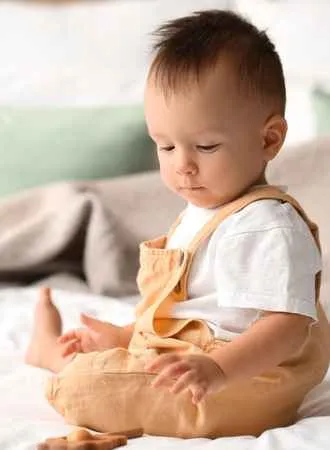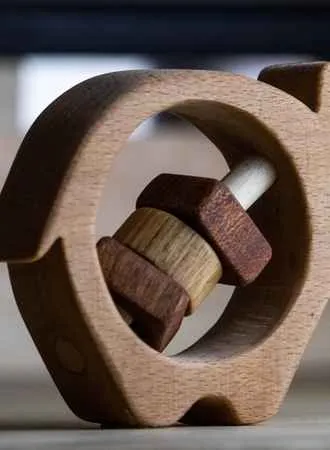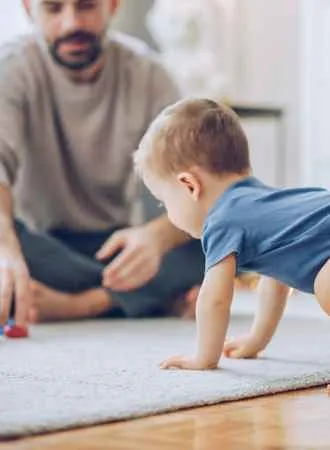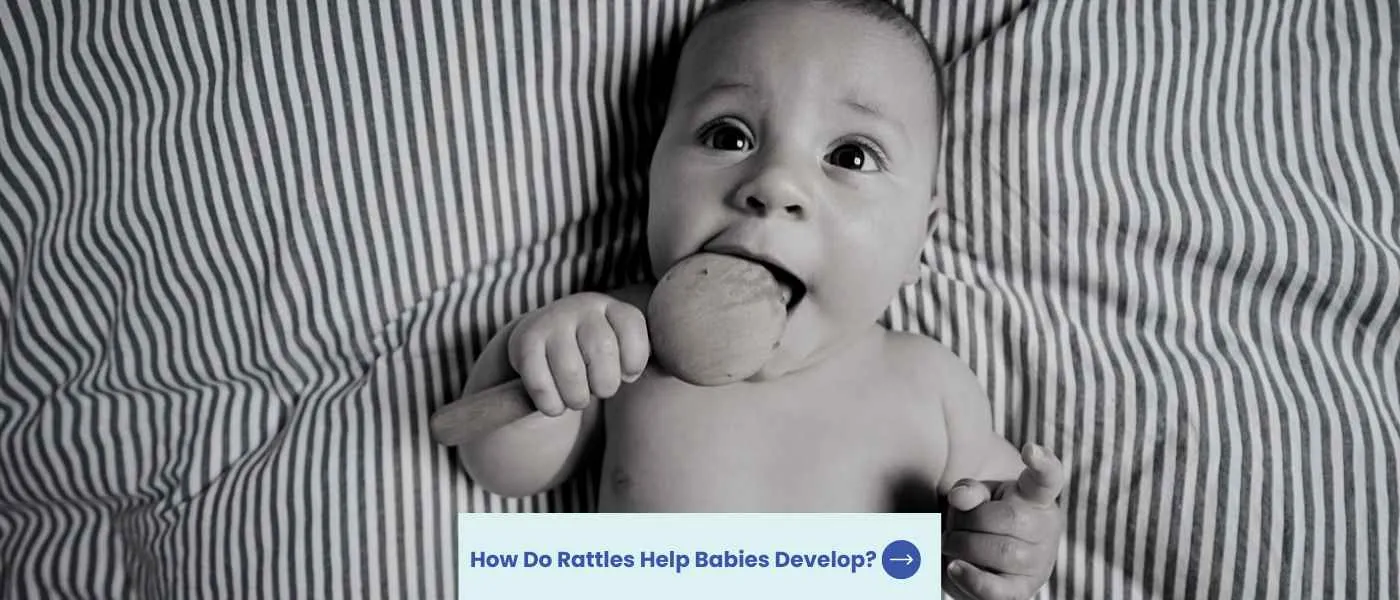Have you ever wondered why rattles are so popular and how they help in a baby’s development?
Rattles can aid in a baby’s cognitive, emotional, and social development. Rattles can help babies learn cause and effect, develop their hand-eye coordination, and promote their motor abilities. Moreover, rattles can also help babies build relationships with those around them by encouraging interaction and turn-taking.
We will delve deeper into how rattles help babies develop and why they are such an essential toy for babies. We will explore the different benefits of rattles for babies and how parents can incorporate them into their baby’s playtime to promote their development.
Key Takeaways on How Baby Rattles Support Child’s Development
Rattles aid development — Rattles can aid in a baby’s cognitive, emotional, and social development by helping them learn cause and effect, develop their hand-eye coordination, and promote their motor abilities.
Language development — Rattles stimulate language development by encouraging vocalization sounds through imitation and providing an opportunity for bonding and communication between parent and child.
Choosing the right rattles — When choosing a rattle for a baby, consider the material it is made of (non-toxic), its size and shape (easy to hold), sound (not too loud or jarring), durability (made of sturdy materials), and safety (no small parts).
Why Should You Buy Baby Rattles
Baby rattles are one of the oldest and most ubiquitous toys for infants. These simple toys offer a variety of developmental benefits for babies.
| Benefit Category | Description |
|---|---|
| Sensory Development | – Auditory Stimulation: The sound of the rattle helps babies develop their sense of hearing. – Visual Stimulation: Bright colors and patterns on rattles can attract a baby’s attention, aiding visual development. |
| Motor Skills | – Grasping and Holding: Rattles encourage babies to practice grasping and holding, essential fine motor skills. – Hand-Eye Coordination: Shaking and manipulating the rattle helps improve coordination between what the baby sees and how they respond. |
| Cognitive Development | – Cause and Effect: Babies begin to understand that when they shake the rattle, it makes a sound, introducing the concept of cause and effect. – Focus and Attention: The sound and movement of the rattle can help improve a baby’s concentration and attention span. |
| Oral Exploration | – Teething Relief: Some rattles are designed with teething surfaces that babies can chew on, providing relief from teething discomfort. – Mouth and Tongue Development: Babies often explore by putting objects in their mouths, and rattles can safely provide this oral exploration. |
| Emotional Development | – Entertainment: The sounds and textures of rattles can entertain and amuse babies, keeping them engaged. – Comfort: Familiar toys like rattles can provide comfort to babies in unfamiliar settings or situations. |
| Social Interaction | – Interactive Play: Parents and caregivers can use rattles to play with the baby, enhancing bonding and teaching social interaction cues, like taking turns. |
| Versatility & Portability | – Travel-Friendly: Rattles are typically small and lightweight, making them easy to carry in diaper bags or strollers for on-the-go entertainment. – Variety: Rattles come in various shapes, sizes, materials, and sounds, offering diverse sensory experiences. |
When choosing a baby rattle, it’s essential to consider factors like the material (ensuring it’s free from harmful chemicals), the size (to prevent choking hazards), and the overall design (to ensure it’s engaging and beneficial for the baby).
Benefits of Rattles for Babies
Babies are naturally curious and eager to learn about the world around them. Rattles are a great tool to help babies develop their cognitive and motor skills. Here are some of the benefits of using rattles for babies:
Development of Fine Motor and Gross Motor Milestones
Rattles help babies with their motor development. As babies grow and develop, they need to learn how to control their movements and develop fine motor skills. Rattles and other baby toys can help with this by encouraging babies to grasp and hold onto the rattle. As they shake the rattle, they are also developing their hand muscles and hand-eye coordination.
Hand-Eye Coordination
Babies tend to explore with their hands. Rattles can also help babies develop their hand-eye coordination. As they shake the rattle, they are learning to track the movement of the rattle with their eyes while also controlling the movement with their hands. This can be especially helpful for babies who are learning to sit up or crawl.
Auditory Stimulation
Banging rattles produce immediate auditory feedback. This can help babies learn about cause and effect and develop an understanding of how their actions can produce a sound. As they continue to shake the rattle, they are also developing their auditory processing skills.
Visual Stimulation
Newborn baby rattles can also provide visual stimulation for babies. Many rattles come in bright colors and interesting shapes, which can help capture a baby’s attention and encourage them to explore the rattle further. This can help develop their visual perception and recognition skills.

How Does a Rattle Help a Child’s Emotional Development?
When it comes to early childhood development, rattles have long been used as an aid for parents and caregivers. But does a rattle help a child’s emotional development?
The answer is yes!
By stimulating the senses through sound, touch and sight, baby rattles can provide important developmental benefits such as improved cognitive abilities, enhanced social skills and even stronger emotions.
Cognitive Development
Rattles can be an effective tool for helping children develop cognitively. They provide a stimulating environment that encourages exploration and learning, which in turn helps to develop motor skills, hand-eye coordination, and problem-solving abilities.
How Does a Rattle Help? Rattles are great tools for engaging young minds. The sound of the rattle stimulates the senses and encourages babies to explore their environment through play.
This type of play is important for developing fine motor skills such as grasping objects, reaching out to grab things, and eventually manipulating toys with both hands. It also helps them learn about cause and effect by shaking the rattle or dropping it on the floor and hearing what happens when they do so.
Benefits of Rattles for Cognitive Development: By providing a stimulating environment filled with sights, sounds, textures, colors, shapes—all within reach—rattles help promote cognitive development in infants and toddlers alike.
Through playing with rattles they learn how to recognize patterns; understand object permanence (the concept that objects still exist even if they cannot be seen); make associations between different objects; differentiate between similar items; build memory recall; increase concentration levels; gain better understanding of spatial relationships; identify differences in size/shape/color/texture etc.; practice sorting items into categories based on these characteristics; as well as improve problem solving abilities by trying new ways to manipulate the toy until it produces desired results.
Parents should use rattles regularly during playtime activities with their child from infancy onwards in order to maximize its benefits for cognitive development.
Different types of rattles should be introduced at various stages throughout the baby’s development, such as simple ones like shakers or bells early on and more complex designs featuring multiple parts later down the line.
This will help keep the little one engaged while simultaneously promoting further learning opportunities along each step of his/her journey towards increased cognition capabilities.
Additionally, parents should strive to maintain eye contact while playing together since this will encourage communication between them which is essential for proper mental growth over time.
Using rattles to help cognitive development can be an enjoyable experience for both the child and parent. Next, we will look at how a rattle helps with emotional development.
In Summary: Rattles are an effective tool for cognitive development in babies and toddlers. They provide a stimulating environment filled with sights, sounds, textures, colors and shapes that encourages exploration and learning. Playing with rattles helps children recognize patterns; understand object permanence; make associations between objects; differentiate between similar items; build memory recall; increase concentration levels; gain better understanding of spatial relationships etc. Parents should use rattles regularly during playtime activities to maximize its benefits for cognitive development by introducing different types of rattles at various stages throughout the baby’s development.
Social Development
How Does a Rattle Stimulate Social Development?
Rattles provide an opportunity for young children to interact with others and practice communication skills. Through the use of rattles, babies can learn how to make sounds, imitate facial expressions, and respond to verbal cues from their caregivers.
Rattles also help babies develop social skills such as turn-taking and sharing. By providing them with a fun toy that encourages interaction between people, rattles can help babies build relationships with those around them.
Benefits of Rattles for Social Development
Rattles are beneficial for social development in many ways. They encourage infants to explore their environment by shaking the rattle or making noises with it. This helps them become more aware of their surroundings and understand cause-and-effect relationships better.
Additionally, playing with a rattle gives babies an opportunity to interact socially with other people in the room by making eye contact or smiling when they hear someone else’s voice or see another person’s face while playing together.
Furthermore, using a rattle helps infants practice language skills such as responding verbally when spoken to or mimicking words that they hear from others in order to communicate effectively later on in life.
Tips for Using Rattles To Enhance Social Development
When introducing your baby to rattles, start off slowly by letting him/her explore the object without any pressure from you first before engaging further into playtime activities like passing it back and forth between each other or talking about what he/she is doing while playing with it out loud so that your baby can begin forming connections between words and actions at an early age.
You should also try different types of rattling games like rolling two rattlers across the floor together which will help teach your child important lessons about taking turns while having fun at the same time. Finally, don’t forget that safety always comes first when using toys – always supervise your child during playtime activities involving objects like rattlers so you can ensure no harm comes his/her way.
Rattles can be a great tool to help children develop their social skills, as long as they are used in the right way. Next, we will look at how rattles can help with cognitive development.
In Summary: Rattles are a great tool to help babies learn and develop social skills. They can encourage exploration, imitation of facial expressions, turn-taking and sharing, language development, and more. To get the most out of rattles for social development: • Start off slowly by letting your baby explore without pressure • Engage in playtime activities like passing it back and forth or talking about what heshe is doing • Try different types of rattling games like rolling two across the floor together • Always supervise during playtime activities involving objects like rattlers
Emotional Development
How Does a Rattle Help with Emotional Development?
Rattles provide young children with an opportunity to explore their emotions in a safe and secure environment. By shaking the rattle, babies can express themselves without fear of judgment or criticism. The sound of the rattle also helps them to focus on something other than their feelings, allowing them to take a break from any difficult emotions they may be experiencing. Additionally, rattles help babies learn about cause and effect as they observe how their actions affect the sound that is produced by the toy.
Benefits of Rattles for Emotional Development
Rattles are beneficial for emotional development because they give children an outlet for expressing themselves without words. This allows them to explore different types of emotions such as joy, sadness, anger, frustration and excitement in a non-threatening way. In addition, rattles can help build self-confidence as babies become more aware of their own capabilities when playing with the toy. Furthermore, rattles can promote social interaction between adults and infants by providing opportunities for shared playtime activities which foster bonding experiences between parent and child.
Tips for Using Rattles to Enhance Emotional Development
When using rattles to enhance emotional development, it is important to remember that each baby will respond differently depending on their individual needs and preferences. It is best practice not to force your child into playing with a rattle but rather allow them time to get comfortable before introducing it into playtime activities; this will ensure that your baby has positive associations with the toy from day one. Additionally, make sure you choose age appropriate toys; look out for any small parts which could pose choking hazards if swallowed by your little one. Finally try varying up your playtime routine every now and then so that your baby does not become bored; this could include changing up where you place the rattle during playtime (elevated surfaces such as tables/chairs) or even adding music into games involving rattling.
Rattles are an excellent way to help young children with their emotional development, and there are many ways parents can use them to help their child grow. Next, we will look at the benefits of rattles for emotional development.
In Summary: Rattles can be a great way to help babies develop emotionally, as they provide an outlet for expression and build self-confidence. Parents should ensure that the rattle is age appropriate, allow their baby time to get comfortable with it before introducing it into playtime activities, vary up the routine every now and then and make sure not to force their child into playing with it.
When to Introduce Rattles to Babies
Age Considerations
Rattles are one of the first toys that babies can hold and play with independently. As a general rule of thumb, babies can start playing with rattles around 3 to 4 months of age. At this age, they can grasp objects and bring them to their mouth, which is a natural reflex for babies. However, every baby develops at their own pace, so it’s important to pay attention to your baby’s cues and readiness to play with rattles.
It’s also important to choose rattles that are appropriate for your baby’s age. Some rattles have small parts that can be a choking hazard for young babies. Look for rattles that are specifically designed for your baby’s age range and follow the manufacturer’s guidelines for use.

Supervision and Safety
When introducing rattles to your baby, it’s important to supervise them at all times. Babies can easily put small objects in their mouth, which can be a choking hazard. Make sure to choose rattles that are safe for your baby and never leave your baby unattended while playing with them.
It’s also important to regularly check your baby’s rattles for any signs of wear and tear. If a rattle is damaged or broken, it can become a safety hazard for your baby. Always discard damaged or broken rattles and replace them with new ones.
Finally, make sure to clean your baby’s rattles regularly to keep them free of germs and bacteria. Follow the manufacturer’s guidelines for cleaning and disinfecting your baby’s rattles.

Choosing the Right Rattle for Your Baby
Material
One of the most important questions to ask when buying rattles is — is the baby rattle safe?
When choosing a rattle for your baby, it is important to consider the material it is made of. Rattles made of non-toxic, BPA-free materials like silicone, wood or fabric are a great choice. These materials are safe for your baby to play with and chew on, and they are easy to clean. Avoid rattles made of materials that may break easily or have small parts that can come loose and pose a choking hazard.
Some rattles can double as teething toys. Teething toys teach babies about tactile stimulation and grasping skills.

Size and Shape
The size and shape of a rattle are important factors to consider. Choose a rattle that is easy for your baby to hold and manipulate. A small rattle with a simple shape is best for newborns, while older babies will enjoy rattles with more complex shapes and textures. A rattle with a handle that is easy for your baby to grip will encourage them to develop their fine motor skills.
Sound
The sound a rattle makes is an important consideration when choosing a rattle for your baby. Look for a rattle that produces a soft, gentle sound that is not too loud or jarring. This will help to soothe your baby and prevent overstimulation. Rattles can produce different rattle sounds or textures that can also help to stimulate your baby’s senses and promote cognitive development.
Durability
Choose a rattle that is durable and can withstand the wear and tear of your baby’s play. A rattle that is easy to clean and made of sturdy materials will last longer and provide your baby with hours of playtime. Avoid rattles that are too fragile or poorly made, as they may break easily and pose a safety hazard.
Tips for Using Rattles with Your Baby
Engaging Your Baby
When using wooden rattles with your baby, it’s important to engage them in playtime activities. Start off slowly by letting your baby explore the rattle without any pressure. This can also helps with your baby’s attention span. Encourage your baby to shake, chew, bang, and suck on the rattle, as this will help them develop their motor skills.
You can also try passing the rattle back and forth or talking about what your baby is doing with the rattle. These activities will help promote social development and bonding between you and your baby.

Variety and Rotation
It’s important to provide your baby with a variety of rattles to play with. This will help keep them engaged and interested in their toys. You can rotate the rattles every few days to keep things fresh and exciting for your baby.
It’s also important to choose rattles that are age-appropriate for your baby’s developmental stage. Avoid buying heavy rattles, as they can be difficult for your baby to lift and play with.
FAQS on Benefits of Rattles
Why are baby rattles good for infants?
Rattles are good for infants because they help stimulate their senses, promote hand-eye coordination, and develop fine motor skills. The sound and movement of rattles attract babies’ attention, encouraging them to reach, grasp, and explore, which aids in their overall cognitive and physical development.
A baby rattle can stimulate social development by encouraging interaction between the baby and their caregivers. As adults shake the rattle, make dull sounds typical for rattles, and engage with the baby, it fosters bonding and communication, helping the baby develop social and emotional skills.
What age should babies use rattles?
Babies can start using rattles around 3-4 months of age when they begin to develop the ability to grasp objects. However, it’s essential to provide age-appropriate rattles that are safe and easy for them to hold.
How do rattles help with language development?
Rattles can help with language development by stimulating the baby’s auditory senses and encouraging vocalization. As babies hear the rattle’s sound, they may start to imitate it by cooing, babbling, or making other noises. This vocal play helps build the foundation for later language development, as babies learn to associate sounds with actions and objects. Additionally, caregiver interaction while using rattles can further support language development through bonding and communication.





